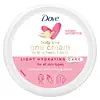What's inside
What's inside
 Key Ingredients
Key Ingredients

No key ingredients
 Benefits
Benefits

 Concerns
Concerns

 Ingredients Side-by-side
Ingredients Side-by-side

Water
Skin ConditioningGlycerin
HumectantNeopentyl Glycol Diheptanoate
EmollientDimethicone
EmollientC12-15 Alkyl Benzoate
AntimicrobialGlyceryl Stearate
EmollientPEG-100 Stearate
Butylene Glycol
HumectantEthylhexyl Palmitate
EmollientCetearyl Alcohol
EmollientSodium Hyaluronate
HumectantCaffeine
Skin ConditioningLactobacillus Ferment Lysate
Skin ConditioningAloe Barbadensis Leaf Polysaccharides
EmollientTrehalose
HumectantPEG-10 Dimethicone
Skin ConditioningCaprylyl Glycol
EmollientSucrose
HumectantHexylene Glycol
EmulsifyingTromethamine
BufferingCarbomer
Emulsion StabilisingAmmonium Acryloyldimethyltaurate/Vp Copolymer
Tocopheryl Acetate
AntioxidantDisodium EDTA
Phenoxyethanol
PreservativeSodium Benzoate
MaskingCI 14700
Cosmetic ColorantCI 19140
Cosmetic ColorantWater, Glycerin, Neopentyl Glycol Diheptanoate, Dimethicone, C12-15 Alkyl Benzoate, Glyceryl Stearate, PEG-100 Stearate, Butylene Glycol, Ethylhexyl Palmitate, Cetearyl Alcohol, Sodium Hyaluronate, Caffeine, Lactobacillus Ferment Lysate, Aloe Barbadensis Leaf Polysaccharides, Trehalose, PEG-10 Dimethicone, Caprylyl Glycol, Sucrose, Hexylene Glycol, Tromethamine, Carbomer, Ammonium Acryloyldimethyltaurate/Vp Copolymer, Tocopheryl Acetate, Disodium EDTA, Phenoxyethanol, Sodium Benzoate, CI 14700, CI 19140
Water
Skin ConditioningDimethicone
EmollientHydrogenated Starch Hydrolysate
HumectantCaprylic/Capric Triglyceride
MaskingStearic Acid
CleansingHelianthus Annuus Seed Oil
EmollientIsohexadecane
EmollientGlycol Stearate
EmollientTriethanolamine
BufferingSodium Acrylate/Sodium Acryloyldimethyl Taurate Copolymer
Emulsion StabilisingGlyceryl Stearate
EmollientCaprylyl Glycol
EmollientPhenoxyethanol
PreservativeCetyl Alcohol
EmollientParfum
MaskingCarbomer
Emulsion StabilisingPolysorbate 80
EmulsifyingDimethiconol
EmollientXanthan Gum
EmulsifyingSorbitan Oleate
EmulsifyingStearamide Amp
Benzyl Alcohol
PerfumingBenzyl Benzoate
AntimicrobialHexyl Cinnamal
PerfumingLimonene
PerfumingLinalool
PerfumingCI 77891
Cosmetic ColorantWater, Dimethicone, Hydrogenated Starch Hydrolysate, Caprylic/Capric Triglyceride, Stearic Acid, Helianthus Annuus Seed Oil, Isohexadecane, Glycol Stearate, Triethanolamine, Sodium Acrylate/Sodium Acryloyldimethyl Taurate Copolymer, Glyceryl Stearate, Caprylyl Glycol, Phenoxyethanol, Cetyl Alcohol, Parfum, Carbomer, Polysorbate 80, Dimethiconol, Xanthan Gum, Sorbitan Oleate, Stearamide Amp, Benzyl Alcohol, Benzyl Benzoate, Hexyl Cinnamal, Limonene, Linalool, CI 77891
Ingredients Explained
These ingredients are found in both products.
Ingredients higher up in an ingredient list are typically present in a larger amount.
Caprylyl Glycol is a humectant and emollient, meaning it attracts and preserves moisture.
It is a common ingredient in many products, especially those designed to hydrate skin. The primary benefits are retaining moisture, skin softening, and promoting a healthy skin barrier.
Though Caprylyl Glycol is an alcohol derived from fatty acids, it is not the kind that can dry out skin.
This ingredient is also used as a preservative to extend the life of products. It has slight antimicrobial properties.
Learn more about Caprylyl GlycolCarbomer is a polymer of acrylic acid. Its main role is to create a gel consistency.
A high amount of carbomer can cause pilling or balling up of products. Don't worry, most products contain 1% or less of carbomer.
Dimethicone is a type of synthetic silicone created from natural materials such as quartz.
What it does:
Dimethicone comes in different viscosities:
Depending on the viscosity, dimethicone has different properties.
Ingredients lists don't always show which type is used, so we recommend reaching out to the brand if you have questions about the viscosity.
This ingredient is unlikely to cause irritation because it does not get absorbed into skin. However, people with silicone allergies should be careful about using this ingredient.
Note: Dimethicone may contribute to pilling. This is because it is not oil or water soluble, so pilling may occur when layered with products. When mixed with heavy oils in a formula, the outcome is also quite greasy.
Learn more about DimethiconeGlyceryl Stearate is a mix of glycerin and stearic acid.
It is used to stabilize the mixing of water and oil ingredients. By preventing these ingredients from separating, it can help elongate shelf life. It can also help thicken the product's texture.
As an emollient, it helps soften skin and supports barrier-replenishing ingredients.
In cosmetics, Glyceryl Stearate is often made from vegetable oils or synthetically produced.
This ingredient may not be fungal-acne safe
Fun fact: The human body also creates Glyceryl Stearate naturally.
Learn more about Glyceryl StearatePhenoxyethanol is a preservative that has germicide, antimicrobial, and aromatic properties. Studies show that phenoxyethanol can prevent microbial growth. By itself, it has a scent that is similar to that of a rose.
It's often used in formulations along with Caprylyl Glycol to preserve the shelf life of products.
Water. It's the most common cosmetic ingredient of all. You'll usually see it at the top of ingredient lists, meaning that it makes up the largest part of the product.
So why is it so popular? Water most often acts as a solvent - this means that it helps dissolve other ingredients into the formulation.
You'll also recognize water as that liquid we all need to stay alive. If you see this, drink a glass of water. Stay hydrated!
Learn more about Water